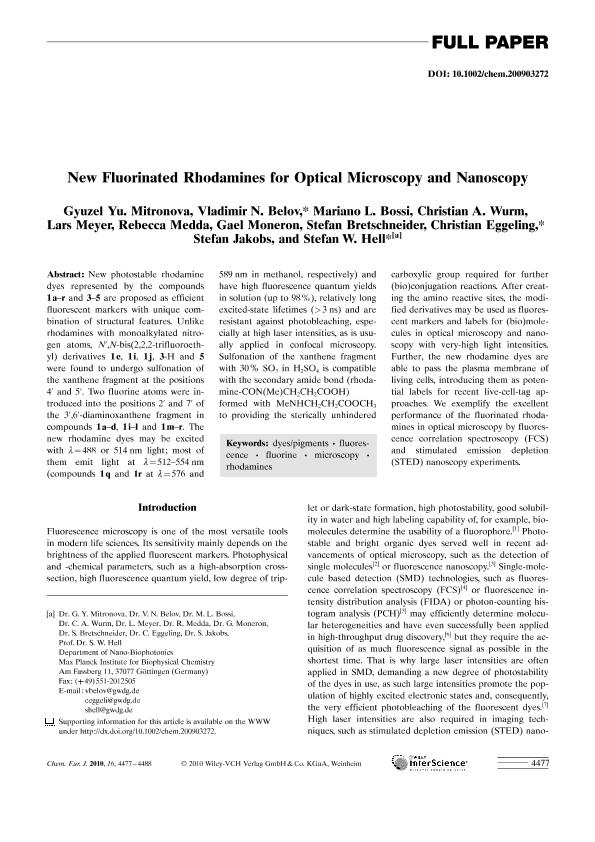Mostrar el registro sencillo del ítem
dc.contributor.author
Mitronova, Gyuzel Yu
dc.contributor.author
Belov, Vladimir N.
dc.contributor.author
Bossi, Mariano Luis

dc.contributor.author
Wurm, Christian A.
dc.contributor.author
Meyer, Lars
dc.contributor.author
Medda, Rebecca
dc.contributor.author
Moneron, Gael
dc.contributor.author
Bretschneider, Stefan
dc.contributor.author
Eggeling, Christian
dc.contributor.author
Jakobs, Stefan
dc.contributor.author
Hell, Stefan W.
dc.date.available
2019-03-18T18:34:04Z
dc.date.issued
2010-04
dc.identifier.citation
Mitronova, Gyuzel Yu; Belov, Vladimir N.; Bossi, Mariano Luis; Wurm, Christian A.; Meyer, Lars; et al.; New fluorinated rhodamines for optical microscopy and nanoscopy; Wiley VCH Verlag; Chemistry- A European Journal; 16; 15; 4-2010; 4477-4488
dc.identifier.issn
0947-6539
dc.identifier.uri
http://hdl.handle.net/11336/71891
dc.description.abstract
New photostable rhodamine dyes represented by the compounds 1a-r and 3-5 are proposed as efficient fluorescent markers with unique combination of structural features. Unlike rhodamines with monoalkylated nitrogen atoms, N′,N-bis(2,2,2-trifluoroethyl) derivatives 1e, 1i, 1j, 3-H and 5 were found to undergo sulfonation of the xanthene fragment at the positions 4′ and 5′. Two fluorine atoms were introduced into the positions 2′ and 7′ of the 3′,6′-diaminoxanthene fragment in compounds 1a-d, 1i-l and 1m-r. The new rhodamine dyes may be excited with λ= 488 or 514 nm light; most of them emit light at λ = 512-554 nm (compounds 1q and 1r at λ=576 and 589 nm in methanol, respectively) and have high fluorescence quantum yields in solution (up to 98%), relatively long excited-state lifetimes (>3ns) and are resistant against photobleaching, especially at high laser intensities, as is usually applied in confocal microscopy. Sulfonation of the xanthene fragment with 30% SO3 in H2SO4 is compatible with the secondary amide bond (rhodamine-CON(Me)CH2CH 2COOH) formed with MeNHCH2CH2COOCH3 to providing the sterically unhindered carboxylic group required for further (bio)conjugation reactions. After creating the amino reactive sites, the modified derivatives may be used as fluorescent markers and labels for (bio)molecules in optical microscopy and nanoscopy with very-high light intensities. Further, the new rhodamine dyes are able to pass the plasma membrane of living cells, introducing them as potential labels for recent live-cell-tag approaches. We exemplify the excellent performance of the fluorinated rhodamines in optical microscopy by fluorescence correlation spectroscopy (FCS) and stimulated emission depletion (STED) nanoscopy experiments. © 2010 Wiley-VCH Verlag GmbH & Co. KGaA.
dc.format
application/pdf
dc.language.iso
eng
dc.publisher
Wiley VCH Verlag

dc.rights
info:eu-repo/semantics/openAccess
dc.rights.uri
https://creativecommons.org/licenses/by-nc-sa/2.5/ar/
dc.subject
Dyes/Pigments
dc.subject
Fluorescence
dc.subject
Fluorine
dc.subject
Microscopy
dc.subject
Rhodamines
dc.subject.classification
Otras Ciencias Químicas

dc.subject.classification
Ciencias Químicas

dc.subject.classification
CIENCIAS NATURALES Y EXACTAS

dc.title
New fluorinated rhodamines for optical microscopy and nanoscopy
dc.type
info:eu-repo/semantics/article
dc.type
info:ar-repo/semantics/artículo
dc.type
info:eu-repo/semantics/publishedVersion
dc.date.updated
2019-03-08T20:18:32Z
dc.journal.volume
16
dc.journal.number
15
dc.journal.pagination
4477-4488
dc.journal.pais
Alemania

dc.journal.ciudad
Weinheim
dc.description.fil
Fil: Mitronova, Gyuzel Yu. Max Planck Institute for Biophysical Chemistry; Alemania
dc.description.fil
Fil: Belov, Vladimir N.. Max Planck Institute for Biophysical Chemistry; Alemania
dc.description.fil
Fil: Bossi, Mariano Luis. Consejo Nacional de Investigaciones Científicas y Técnicas; Argentina. Max Planck Institute for Biophysical Chemistry; Alemania
dc.description.fil
Fil: Wurm, Christian A.. Max Planck Institute for Biophysical Chemistry; Alemania
dc.description.fil
Fil: Meyer, Lars. Max Planck Institute for Biophysical Chemistry; Alemania
dc.description.fil
Fil: Medda, Rebecca. Max Planck Institute for Biophysical Chemistry; Alemania
dc.description.fil
Fil: Moneron, Gael. Max Planck Institute for Biophysical Chemistry; Alemania
dc.description.fil
Fil: Bretschneider, Stefan. Max Planck Institute for Biophysical Chemistry; Alemania
dc.description.fil
Fil: Eggeling, Christian. Max Planck Institute for Biophysical Chemistry; Alemania
dc.description.fil
Fil: Jakobs, Stefan. Max Planck Institute for Biophysical Chemistry; Alemania
dc.description.fil
Fil: Hell, Stefan W.. Max Planck Institute for Biophysical Chemistry; Alemania
dc.journal.title
Chemistry- A European Journal

dc.relation.alternativeid
info:eu-repo/semantics/altIdentifier/doi/https://doi.org/10.1002/chem.200903272
dc.relation.alternativeid
info:eu-repo/semantics/altIdentifier/url/https://onlinelibrary.wiley.com/doi/full/10.1002/chem.200903272
Archivos asociados
